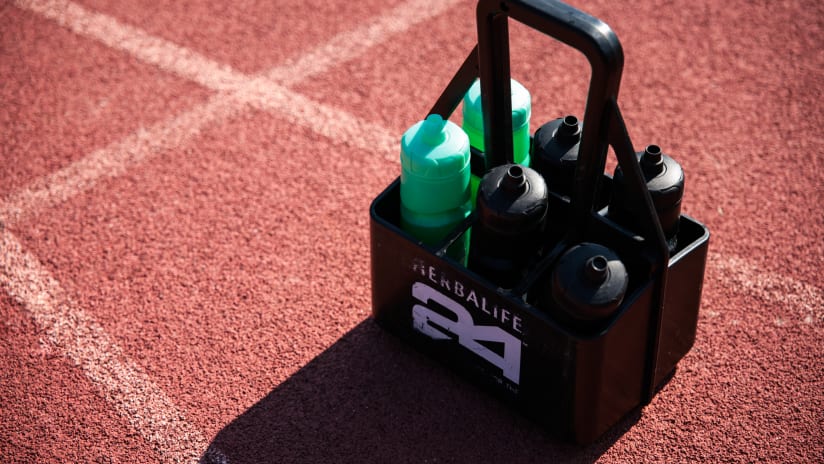Herbalife is the sports nutrition and presenting partner for the LA Galaxy. Registered Dietitians at Herbalife work closely with the LA Galaxy technical staff to make sure we are maximizing their nutrition to support performance goals.
As an athlete, maintaining a healthy and well-balanced diet is essential for optimal performance on the field. When schedules get busy between training and travel, and also school for the student-athlete, dining out and on the go is a common occurrence. Finding nutritious options while eating out at restaurants can often be challenging, so we’ve put together 10 practical tips to help you make smart choices to fuel your body.
1. Plan Ahead
Before heading out, taking a few moments to peruse menu options online can help set you up for success. Knowing what is on the menu and choosing your meal beforehand can help you make better decisions that align with your nutrition goals. Some establishments even provide nutrition information for their menus on their websites, helping you to make an educated decision before arriving at the restaurant. This way, you are not under time pressure to decide on a meal when you are at your hungriest while seated at the table or standing at the register to order. Even better, keep a list of your go-to orders in your phone Notes app to help you stay on track when you unexpectedly end up dining out.
2. Be Smart with Your Starters
Your starters can set the tone for the meal. Begin with nutrient-packed starters rather than fried or high calorie options. Stick with grilled vegetables, salads, and soups to kickstart the meal. This will help you prevent overindulgence and control your appetite before the main course arrives, and is another opportunity to add nutrient-rich vegetables in your meal plan.
3. Stick to Your Performance Plate
When in doubt, stick to your performance plate to build a well-balanced meal. Always fill your plate with a mix of lean protein, carbohydrates, fruits and vegetables, and beneficial fats. Choose grilled proteins with whole grains when possible, and add color to your plate to ensure you obtain a balance of macronutrients and variety of micronutrients.
4. Keep Your Portions in Check
Restaurants often serve massive portions that can throw off your game. Check in with yourself when your order hits the table to plan how much you should consume. If you are satisfied before you consume the full serving, stop eating. If you are still hungry after you complete the full portion, take it bite-by-bite and stop when you are satisfied, but not stuffed. You can also opt to share an entree rather than order individual dishes, or order a half-portion to avoid overeating.
5. Hydrate Like a Pro
Hydration is non-negotiable for athletes, so pick the beverage that best serves you. Instead of sugary sodas lacking nutrient value, choose water, unsweetened tea, and other low calorie options. Alcohol can negatively impact your hydration levels and reduce recovery, so be sure to limit your intake.
6. Watch Out for Hidden Calories
Be vigilant about hidden calories, especially in beverages, sauces, and dressings. Watch out for mayo-based dressings or aiolis along with the words “creamy” or “cheesy”, as these items are usually higher in fat, adding unneeded calories to your meal. You can ask for sauces and dressings on the side in order to have more control over your intake. Some lower calorie condiments include ketchup, mustard, and salsas. Opt for menu options that come grilled or baked rather than fried to cut back on unhealthy fats and excess calories.
7. Communicate Dietary Needs
If you have any dietary restrictions or follow a specific nutrition plan, don’t forget to utilize your server. Communicate any allergies and preferences to the restaurant staff, as they should be trained and knowledgeable about what goes into each menu item. Many restaurants are happy to accommodate special requests or suggest alternatives, so it never hurts to ask. Speaking up can help you better meet your nutritional needs on the road.
8. Tune into to Your Body
Always listen to your body when eating and make choices that leave you feeling satisfied and energized. Pay attention to how you feel throughout the meal, checking in with your hunger and fullness levels. Enjoying a meal out with friends and loved ones should be an enjoyable experience, so try not to rush it. Be sure to slow down while eating to get the most satisfaction out of your meal. Stopping when you are satisfied and not overstuffed prevents you from overeating, getting digestive discomfort, or feeling sluggish later on or even into the next day.
9. Take Leftovers To-Go
When you are satisfied with your meal and no longer hungry, ask for a to-go box to take the remainder home with you. But please note, if you won’t be home for a few hours, it is often a better idea to forgo the to-go box to prevent foodborne illness.
10. Keep Nutritious Snacks Handy Between Meals
If you often get over-hungry when out and about, it may be a good idea for you to keep some nutrient-dense snack options on-hand instead of stopping for fast food. Keeping a few go-to items in your bag or car can help keep your energy levels stable and prevent you from becoming ravenous before your next meal. Some beneficial options include fresh fruit, applesauce packets, nuts, trail mix, or protein bars. If stowing snacks in your car, be wary of the weather and consider using a small cooler bag to keep your food safe and unmelted.
Elevating your performance is not just about what you do on the field - it is also about what you consume. Proper nutrition and fueling can help take you to the next level. Add these tips to your playbook for making better fueling choices when dining out or on the go. As an athlete, fueling your body properly contributes to your wellness and success both on and off the field.




